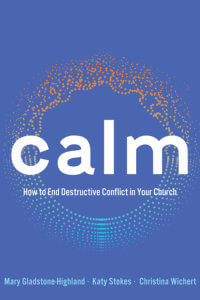Voting is part of the organizational culture of many congregations. But it can create winners and losers, leaving a bad taste in people’s mouths. While there are times when voting is necessary and even desirable, churches should consider, explore, and adopt other methods of collective decision-making whenever possible, according to Mary Gladstone-Highland, Katy Stokes, and Christina Wichert, authors of a new book on reducing conflict in churches.
Let’s face it, voting is often enthroned as “the” method of collective decision-making used by groups seeking to be fair and democratic and is therefore incorporated into organizational standards or rules of order. But outside of those scenarios where voting is specifically required by church bylaws, we are convinced there is a better way to move forward.
Voting: the pros and cons
There’s no denying it — voting is firmly entrenched in American culture. It’s fast, it’s easy, it’s efficient, and it’s simple. Encounter a decision to be made, propose the options, count, and decide. And for the most part, once a vote is counted, the outcome of that vote is generally considered fair. At least (or should we say especially?) by the winning majority. And typically, as we all know, voting rules stipulate winner-take-all outcomes.
And so, the issue begins to emerge — especially as we consider collective decision-making in church context. It’s not to say that voting is inherently bad or problematic; there are clear benefits to decision-making by voting. But churches can and should be a place to reflect on why we adopt the practices and habits that we do. Reflecting on why we typically make collective, group decisions by voting, we might ask: The benefits to voting might indeed make things simpler, faster, and more efficient, but at what cost?
Consider this scenario: Your church is trying to decide whether or not to change the time of a Sunday worship service. Thirty people are present for the vote. Sixteen individuals vote in favor of changing the time and fourteen vote against ending in a simple majority-rule situation, the change is adopted, even though that majority only represents the opinion of 53 percent of those who voted.
So, a decision is carried that, true, over half of those present to vote supported. But were those in favor strongly in favor? Or did folks without any strong feelings on the issue vote because of how the issue was presented in the meeting? Maybe those who opposed, opposed strongly, but just didn’t have the numbers on their side that particular evening. Who was present to vote? Were the people who could be affected most by the change invited or able to attend the vote? In other words, was deciding by voting truly “fair”?
Majority-rule situations can easily silence a significant number of voices and trample over opinions. It’s no wonder, then, that decisions by majority-rule voting can leave a bad taste in folks’ mouths, at best, and can cause real trauma to those who feel unheard and unvalued by the church body, at worst. Has anyone really “won” in such a scenario? For these reasons, we strongly encourage churches not to give up voting completely, but to consider, explore, and adopt other methods of collective decision-making whenever possible.
Consensus: the pros and cons
An alternative way to make a decision collectively is to reach consensus. To reach a true consensus, each individual involved in the process voices a position. Ultimately, everyone involved agrees to support the final decision made, though it may not be everyone’s favorite choice. Reaching consensus takes a large amount of dedicated buy-in up front, as those involved must commit to making a decision that’s best for the group as a whole, instead of competing for their own preferred preferences.
There are many different ways and means of reaching consensus for both small and group settings. If you’re interested in exploring the subject more, the Session Lab is a great online resource with a library of facilitation methods and practices for consensus-building and collective decision-making.
Let’s be clear: compared to voting, reaching consensus takes much more effort and time. Consensus-building generally also requires the role of a third-party facilitator to keep the process on track. Transparently speaking, some may even describe the process as tedious, and sometimes reaching consensus can be uncomfortable and contentious. But the group’s commitment to hearing all voices and buying-in to the process from start to finish highly increases the likelihood of reaching a successful outcome.
The dangers of groupthink
A word of caution: Sometimes what is thought of as “consensus” may actually be something else quite different: a group dynamic known as “groupthink.” Groupthink occurs when loyalty to the group requires each member to avoid raising controversial issues which results in a decision made without critical thinking or an evaluation of the possible consequences or alternatives. In other words, groupthink occurs because group members want to seem agreeable, are afraid to voice their opinions, and avoid ruffling feathers.
The desire to maintain group cohesion, which can provide a sense of safety and belonging, is a strong one and isn’t necessarily a problem in itself. But groupthink often happens due to strong outside pressure, coming either from a strong and persuasive leader or from the group itself. Groupthink can cause individuals to put aside their personal beliefs and adopt the majority option, which does not represent consensus.
Again, imagine a church trying to reach a decision around changing the Sunday worship service time. Church leaders are trying to reach a consensual decision and have invited the congregation to discuss the different options. The discussion seems to be going smoothly at first, with some speaking for and against the change openly and respectfully of one another. And then John Doe speaks up. His family has been a part of the church since its doors first opened (as he often likes to remind people) and has been generous with their wealth when it comes to supporting church ministries. He is against the change. He speaks firmly, though not derisively. But after he speaks, the once-robust debate quickly simmers. Little more than some meekly affirmative head-nods — though maybe with pursed lips and downward glances — come from those who, prior to Doe’s arrival, had been in favor of the change. That’s groupthink.
Facilitators leading groups in consensus-building should look out for signs that groupthink may be at play, such as one individual or cohort seeming to stifle discussion or wield influence in such a way that others seem hesitant to contradict them. If these things begin to happen, there are ways to counteract the power dynamics at play. Break into smaller groups to discuss issues separately. Continue to give group members regular opportunities to share their ideas and thoughts. Provide opportunities to share ideas or thoughts anonymously.
 This material is excerpted from Calm: How to End Destructive Conflict in Your Church (Abingdon Press, 2023) by Mary Gladstone-Highland, Katy Stokes, and Christina Wichert. Used by permission. The book is available at Abingdon Press, Cokesbury, and Amazon.
This material is excerpted from Calm: How to End Destructive Conflict in Your Church (Abingdon Press, 2023) by Mary Gladstone-Highland, Katy Stokes, and Christina Wichert. Used by permission. The book is available at Abingdon Press, Cokesbury, and Amazon.
Related Resources
- 3 Key Skills for Leading in Today’s Argumentative Climate by Joel Snider
- The Art of Forging a Meaningful Consensus by Ann A. Michel
- Meet with a Purpose by Mike Bonem
Image by rawpixel.com on Freepik







